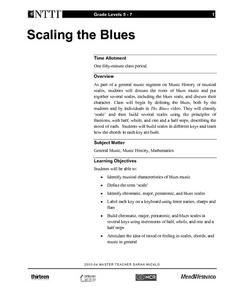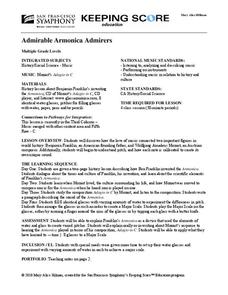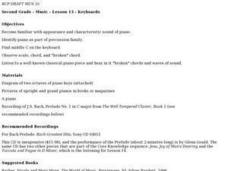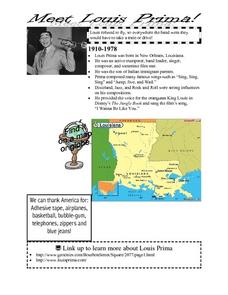Music Fun
Overhead Transparencies
Classroom and studio music instructors will find this packet of 10 transparencies of major value. Images of treble and bass clefs, notes and rests, note values, time signatures, and music language are included. Nothing minor about this...
Curated OER
Scaling the Blues
Students identify musical characteristics of blues music and define the term 'scale.' They identify chromatic, major, pentatonic, and blues scales and label each key on a keyboard using letter names, sharps and flats.
San Francisco Symphony
Admirable Armonica Admirers
What do Ben Franklin and Wolfgang Mozart have in common? Find out about the musical invention, the armonica or glassy-chord. Learners will read about how Ben Franklin invented this new instrument and how Wolfgang Mozart came to play it....
Fun Music Company
Classification of Intervals
Major 2nd, Perfect 4th, Minor 3rd. The number and classification of intervals are the focus of a one-page worksheet that asks musicians to write the intervals above given notes and to indicate the classification of others.
Curated OER
KEYBOARDS
Second graders become familiar with appearance and characteristic sound of piano, identify piano as part of percussion family, find middle C on the keyboard, observe scale, chord, and "broken" chord, and listen to a well-known classical...
Curated OER
Lines & Spaces; Another Round
Fourth graders recall the letter names of the notes of the C-major scale and identify the names of the C-major scale. They identify the names of the lines and spaces on a music staff. They sing rounds.
Berklee College of Music
Create Your Own Afro-Latin Groove
The backbone of Latin American music is the beat! Young musicians work on blending Afro-Latin rhythms and beat patterns before incorporating the major pentatonic, minor pentatonic, and blues scales in their own compositions.
Fun Music Company
Working Out the Key
"Gimme an E minor!" Or any key for that matter. But how do you figure out the key of a piece of music? Here's a worksheet that shows young musicians three easy steps to help them identify the key of a piece of music.
Curated OER
Meet Louis Prima!
Students discover the difference in major and minor tonality after a brief introduction to Louis Prima. They discuss swing dancing and Louis Prima's role in the "Jungle Book" as the character King Louis. Students listen to the song...
Special needs in Music
Music Work Sheet (Special Ed)
Music is beneficial for all learners. Help your learners with special needs learn about different styles of music, as well as the ways that music is represented on paper, with 30 different worksheets.
Curated OER
Music of My Heart
High schoolers view and discuss the movie, Music of the Heart. They compare/contrast two versions of the song, Music of My Heart, identify characteristics of heroes, and sing the song, Music of My Heart.
Curated OER
Chords and Triads
In this music worksheet, students answer 15 questions related to chords and triads. For example, "A triad is a ...that is made up of three notes."
Curated OER
Mood in Music
Students portray the mood of a piece of music in a drawing. In this mood in music lesson plan, students discuss how music creates a mood. Students listen to Vivaldi's "Four Seasons," "The Wreck of The Wreck of the Edmund...
Curated OER
GCSE Notes 2000: Classical Music
Classical period music is defined by its characteristics and distinctive sound. A set of notes assists upper graders in recalling and analyzing music from the classical period based on musical terminology. An example analysis of Eine...
Curated OER
Chords and Triads
In this chords and triads music worksheet, students respond to 7 fill in the blank and short answer questions pertaining to the playing of chords and triads.
Curated OER
VH1 Driven: Jamie Foxx, Lesson 2
Learners compare and contrast classical piano style with jazz piano style. They watch a segment of the video, "VH1 Driven: Jamie Foxx," participate in a class discussion of the music from the video, and develop a list of adjectives for...
Curated OER
Three Pieces for Chamber Orchestra, Movements 1 & 2 By Arnold Schoenberg
Students study composer, Arnold Schoenberg. They compare landscapes to soundscapes and study abstract art and abstract music. They answer questions and write about both in their journals. They identify abstract artist and composers...
Music Theory
Music theory.net: Scale Degrees
A thorough explanation of scale degrees and the various names for each note. Provides illustrated examples and audio clips to enhance the lesson. Terrific resource for music students and teachers!
Open Curriculum
Open Curriculum: Minor Keys and Scales
To discuss the interval patter of minor scales and their difference from major scales
Other
The Tonal Center/diatonic Scales
A comprehensive summary of basic music theory. Commentary is thorough yet practical. Information on tonality, chords, scales, cadences, etc. This pages is on diatonic scales.
Open Curriculum
Open Curriculum: Octaves and the Major Minor Tonal System
To introduce the relationship between frequency, octaves, major, minor, and chormatic scales, and tonal music
OpenStax
Open Stax: Catherine Schmidt Jones: Scales That Aren't Major or Minor
As the title suggests, this site defines and gives examples of various other types of scales including chromatic, whole tone, blues scales and more.
Music Theory
Music theory.net: Diatonic Triads
Descriptions of diatonic triads: major, natural minor, and harmonic minor. Provides animated illustrations, and a printable chart at the end of the lesson.
Open Curriculum
Open Curriculum: Scales That Are Not Major or Minor
To explain the various musical scales that cannot be classified as major or minor such as chromatic, whole-tone, pentatonic, blues, and scales from non-Western music























